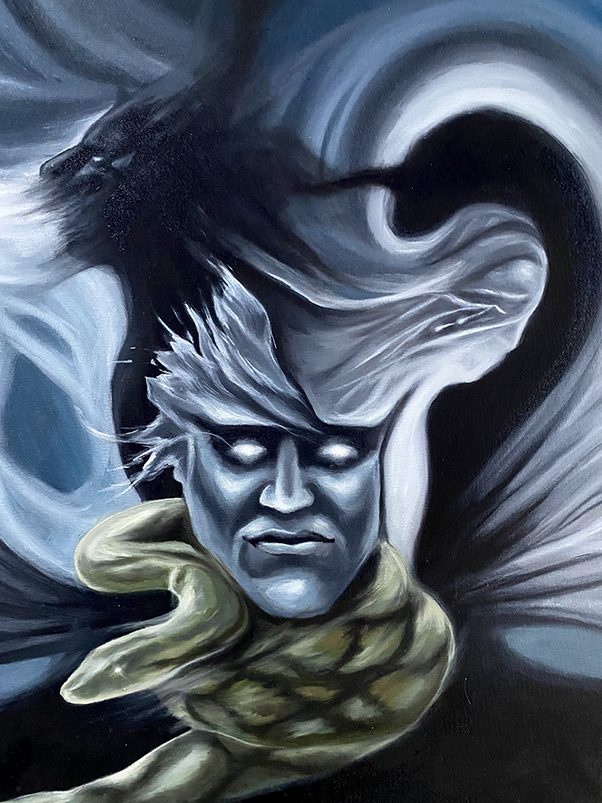

The root of the Victim archetype is a fear that you cannot survive or will not survive. Not just physical survival but the survival of your identity, your hopes and dreams or sense of self.
Driven by an unconscious belief that you don’t deserve to thrive, the Victim is a way to cope with loss of power and an attempt to control through passivity. As a Victim, you lose touch with your intrinsic value. This inevitably leads to blaming others, feeling worthless, powerless, stuck, separated from others, and alienated from joy and freedom. When you believe you are worthless you stop trusting in yourself, deepening the separation and the sense that you no longer belong.
Behavior: No energy, strong draw toward addictive behaviors, constant need to distract yourself, blaming yourself or others, complaining often and loudly, withdrawal from others, apathy passivity or forceful and controlling.
Emotions: Feels angry, frustrated, hurt, depressed, guilty, shameful, worthlessness and hatred.
Shadow Victim Storyline: It’s not my fault/It’s all my fault, I am always getting hurt, no one really understands me, I can’t, It will never work, I didn’t have a choice, this always happens to me and so on.
Everyone has a Victim archetype. Feeling victimized is a universal human experience. There are obvious expression of this archetype and some not so obvious one. Here are a few examples of the nuance and complexity of this archetype:
Victims are entitled. You feel entitled to your disappointment or anger because of unmet expectations. You feel you deserve (fill in the blank). You have been unfairly treated and wronged. This entitlement can lead to a superiority complex and narcissistic behaviors designed to protect you from the sense of powerlessness you fear.
Victims victimize others. When you are irritated by someone’s victim mentality, you are in that moment a victim to a victim. When you are feeling victimized yourself, you are almost always in the act of victimizing someone else, creating a vicious cycle. For example, when you are feeling like a victim, you a.) withdraw from others, b.) lash out at others. This can be painful for loved ones and can feel like victimization for them.
Victims feel powerless and have poor boundaries. You feel stuck and helpless to change your situation and passively allow others to abuse you and/or you become your own abuser by beating up on yourself, speaking harshly and regarding yourself with disdain and self-loathing.Having lost all boundaries of self-protection you alternate between lashing out like a cornered animal and withdrawing into isolation and depression.
Victims blame others. To be a victim there must be a culprit, someone or something that has robbed you of your power. You abdicate responsibility (and therefore power) in exchange for blamelessness. Someone is to blame for your situation, and it is never you.
Victims are enablers. You enable others who feel victimized by sympathizing and reinforcing their victimization and their indignant sense of being wronged. You need evidence of other victims to remain unconscious of your behavior. You offer this fortification to others as justification and proof of your victimization.
It is so easy to get stuck in Victim energy and once stuck there and caught in its justifying loop, it is difficult to work yourself out of it. To help you understand the Victim better I will go over the three main facets of this archetype.
- Self-Pitying/Helpless Victim
- Tormenting/Perpetrator Victim
- Self-Important/Narcissist Victim
Self-pitying/Helpless Victim experiences: shame, doubt, inferiority, and helplessness. Self-pity is an attempt to self-care. Helplessness stems from fear of doing something wrong and an attempt to feel blameless.
Tormenting/Perpetrator experiences: Anger, rage, frustration, abusing self and others, feeling justified in lashing out. This abuse of self and others is an attempt to have courage and feel powerful.
Self-Important/Narcissist experiences: Denial,lacks personal insight,superiority complex, accusations and judgment, blame and finger pointing. Self-importance and narcissism are attempts to feel worthy and valuable.
The Empath
The Empath is the light side of the Victim. It too, is a universal human quality. Empathy is what sets us apart from the lower animals. It is a uniquely human ability. To feel with another, to feel for another, to be able to imagine another’s experience. To have true empathy and compassion you must be free of your own triggers, irritations, reactions, and other discomforts. This requires a transformation of the Victim by working through the shadow elements and bringing them into your awareness. The Empath takes full ownership for all aspects of their life but does not attempt to control reality. This frees you from resistance and opens you up to empathy and the wisdom of compassion.
The first person requiring your empathy is yourself. The Empath cultivates a space of allowance and acceptance within to begin the process of healing. Fear must be acknowledged and understood, as it is one of the base emotions driving the Victim. The Empath seeks understanding as a pathway to freedom and personal responsibility. When you understand yourself and your behavior from a place of truth, compassion and kindness are natural responses. The Empath has clear and effective personal boundaries. (As mentioned in other articles, boundaries are for you. They are not expectations or ultimatums.) In my discussions with others, I have found that many people find the word boundaries to be misleading or lacking in clear definition. I will often use the word container as a replacement word. This is helpful visually. A container holds, carries, protects, and shelters. The container is for yourself, a place of safety and personal power. It is also this ability to create a container for oneself, that gives the Empath the skills to do the same for another. To have compassion is to create a container for the other, to allow the fullness of their expression and their experience to be witnessed. This requires you to get close to another’s suffering without become a victim to it. Trying to fix someone, or the well-meaning offers of help, are often attempts to escape our own discomfort at others’ pain. Empathizing and having compassion requires great strength and diligence. Staying with another while they suffer without needing to change it, soothe it, fix it, alter it in any way is true compassion and empathy. This is the great power of the Victim transformed into the Empath. Vulnerability is the keystone of your strength. Vulnerability makes you pliable and willing to be changed by your circumstances without losing your power.
Three Facets of the Empath
- Compassionate/Loving
- Courageous/Powerful
- Worthy/Humble
Self-pitying/Helpless Victim needs to: Break secrets and silence, expose danger, be visible and name and honor their experience. Often this requires confrontation of abuser/violator. Accept reality as it is and seek deeper understanding of the self.
Result: Compassion, self-love, self-care, and reclamation of lost identity and innocence.
- The Self Pitying/Helpless Victim becomes the Compassionate/Loving Witness
Tormenting/Perpetrator needs to: Stand up for themselves, take responsibility for actions, look inward without blame or justifications.
Result: Healthy boundaries, has a voice, can help and protect others, has renewed strength and confidence.
- The Tormenting/Perpetrator becomes the Courageous/Powerful Voice
Self-Important/Narcissist needs to: Look inward for answers, seek the truth with humility, recognize and name their own value and the value of others. Express gratitude and seek to serve others through greater purpose.
Result: Self-worth, clear sight, integrity, discovery of a purpose beyond the self.
- The Self-Important/Narcissist becomes the Worthy/Humble Servant
Self-Check:
Of the three facets of the Victim where do you most often find yourself?
- Self-Pitying/Helpless Victim
- Tormenting/Perpetrator Victim
- Self-Important/Narcissist Victim
Can you imagine the process of transforming into the three facets into their Empathic counterparts? What will you need to do specifically?
- Compassionate/Loving
- Courageous/Powerful
- Worthy/Humble
The Victim/Empath archetype is a powerfully transformational archetype. Don’t get discouraged working with it and be gentle with yourself through the process. I hope this article provides an opportunity to explore this archetype more deeply and effectively.
